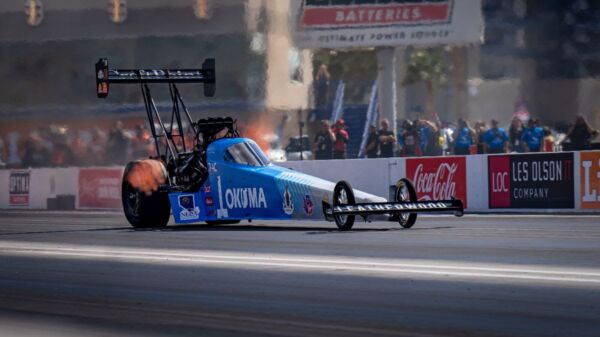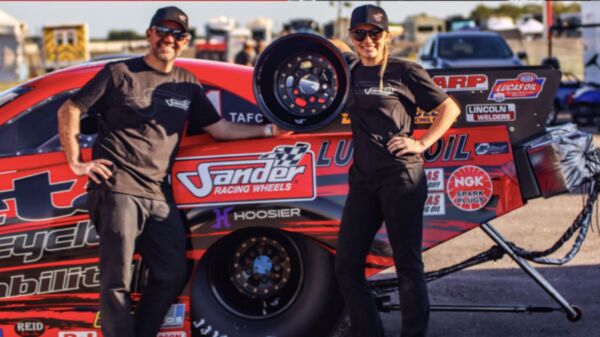The Don Garlits Museum of Drag Racing has released the names of the individuals to be inducted into the museum’s International Drag Racing Hall of Fame on March 10.
The inductees include one of the founding fathers of organized British drag racing, the most dominant campaigner in IHRA Pro Modified competition, one of hot rodding’s most successful early pioneers, a World War II POW camp survivor who went on to enjoy a long and industrious racing career, one of the most prolific winners as crew chief in the Top Fuel and Funny Car categories and a formidable Top Fuel racer who went on to enjoy a lengthy tenure as the NHRA Chief Starter. Additionally, the Founder’s Award will go to a former racer who became one of the most distinguished individuals in the aftermarket industry and the Pat Garlits Award will be presented to a generous lady who gave back so much to the sport she loves.
The Inductees are:
The late Stu Bradbury (Wellingborough Northants England NNE) was a Chief Starter, builder of drag racing venues, and the founding chairman of the British Drag Racing Hall of Fame. Bradbury made a number of significant contributions to England’s quarter-mile scene and has been recognized as one of the sport’s most influential personalities. Bradbury became acquainted with the sport when he stumbled across a display of hot rods and dragsters organized by the British Drag Racing Association, which he quickly joined. In 1965, he and his parents provided accommodation to club president John Bennett while a drag strip was being developed on Podington aerodrome. Bradbury himself assisted in the digging and painting of the track for what became Europe’s first permanent drag strip, Santa Pod Raceway, which opened in 1966. Bradbury was promoted to Deputy Starter and then Chief Starter in 1968, Santa Pod soon became an international attraction for racers from the United States, Scandinavian, Netherlands, South Africa and more. Among the American superstars who made the trek to Santa Pod were Don Garlits, Don Prudhomme, Don Schumacher, Raymond Beadle, Gene Snow and Tony Nancy. Bradbury returned the favor by spending time on the NHRA starting line with NHRA Chief Starter Buster Couch. Bradbury left his Chief Starter position in 1990 to join John Woolfe Racing to develop a NHRA-sanctioned track at the Long Marston Airfield, which later became Shakespeare County Raceway. As a tribute to many departed friends, he and several colleagues founded the British Drag Racing Hall of Fame, assisted in the restoration of Europe’s first dragster, Sydney Allard’s 1961 entry, and then lent support to Santa Pod’s Dragstalgia event, which became Europe’s premiere affair. Bradbury experienced ill health in his later years, but with the support of his wife Bev and daughter Genna, he worked diligently to promote the quarter-mile sport in the UK until his passing.
Scotty Cannon (Lyman, SC) played a major role in the creation and subsequent popularity of the Pro Mod class with his flair for showmanship and domination of the category during the 1990s. He won 28 IHRA Pro Mod races in 45 final round appearances and six season championships. Cannon grew up in an area of the country that was dominated by oval track racing, but he preferred the straight-line action of the quarter-mile and began quarter-mile competition at age 16 in 1982. Cannon had discovered that he had a natural love for drag racing, going straight, and making his cars go as fast as they could possibly go. Cannon also entertained his fans with his distinctive Mohawk haircut, which he began wearing at the beach and increasingly more frequently at the drag strips, where it became his trademark. In the late 1980s, Cannon began racing in “Quick 8” competition and won many a race on hole-shots. He raced in IHRA Top Sportsman and in 1989 became the first and only driver to win the Saturday night Quick Eight and Sunday 32-car bracket competition. By the time IHRA made Pro Mod an official eliminator, Cannon was primed for national domination and won six IHRA World Championships. His 28 national event wins record stood as the winningest, when IHRA ceased to contest Pro Modified many years later. For the 1999 season, he switched to NHRA to compete with a nitro Funny Car and create a colorful rivalry with John Force. He made a spectacular transition to the new category and was named the NHRA Rookie of the Year. Cannon returned to IHRA Pro Modified in 2004, and began serving as crew chief for his son, Scott Cannon’s Pro Mod 1968 Pontiac Firebird in 2005, which resulted in the IHRA World Championship in 2007. Cannon drove in Top Fuel in 2006, after which he retired because of recurring back problems following multiple back surgeries after a skiing accident at age 13. He now is retired and still follows the sport in which competed with great passion.
Jack Ewell (Los Angeles, CA), who was known as the “Silver Fox” because of his prematurely gray hair, was a hot rodder during the earliest days of the sport as he competed with a series of flathead Ford-powered roadsters in the late 1940s. Ewell was there with his nitro-burning ’28 Ford Model A when the first legal drag strip in the country opened in Santa Ana, CA in 1950 and became organized drag racing’s first Top Eliminator. In 1953 he became the first drag racer to top 140 mph in the quarter-mile. He also made annual treks to the Bonneville Salt Flats of Utah to make straightaway passes with a variety of cars and gained admittance to the exclusive Bonneville 200-MPH Club with a record-breaking 212 MPH two-way average in the Chrysler-powered ’53 Studebaker. That same year he won Top Eliminator at the prestigious Bakersfield March Meet. Ewell became the first president of the United Drag Racing Association (UDRA) in 1963 and continued to compete until 1967, when he decided he could not do justice to both tuning and driving and exited the cockpit after a 223-mph pass. He selected the bright, young Carl Olson, a longtime crew member, as his successor. The move was the beginning of Olson’s stellar career as he scored his first Top Fuel victory. In 1972, after wrenching several of Mickey Thompson’s Funny Cars, he teamed with Vince Rossi, Tom Lisa, and Bill Tidwell to race the “Spaghetti Benders” rear-engine streamliner, which became the first West Coast car and second ever to top 240 mph, nearly 20 years after Ewell’s record-breaking 140 mph run. Ewell was also major figure in the aftermarket industry, working as manager for Mickey Thompson’s speed shop and was also employed at Ansen Automotive, Keith Black Racing Engines, Vel’s Parnelli Jones Ford Racing Team, Douglas Headers and Holley Carburetor. Ewell became ill at the early age of 50 and passed away in 1978.
The late Jack Moss (Amarillo, TX) enjoyed a lengthy racing career that began in the formative days of hot rodding, but before he began that chapter of his life, he had to endure the challenges of being a Japanese Prisoner of War for 3-1/2 years. He joined the U.S. Army at age 17 in 1940 and was taken prisoner by the Japanese on January 11, 1942, and was forced to work on the “Death Railway” on such projects as the Bridge on the River Kwai. During the 42-month period, 57% of his unit, known as the “Lost Battalion” was lost. After he was released when the war ended in 1945, he vowed to live life to the fullest, He married a beautiful farm girl, Nellie, and raised a family of two sons and a daughter. He started his own business, Moss Automotive and began winning racing trophies in 1948 at the Amarillo Speedway and the Bonneville Salt Flats. His first dragster smashed the old speed record of 130 mph with a time of 149.5 mph. Moss built more than 30 cars in his lifetime. His “Ramblin’’ Ram’ earned him the nickname of “Jack the Giant Killer” because it was the first single engine dragster to outrun a twin. He went on to build a twin of his own that outran most of the competition and also raced go karts, micro midgets, sprint cars, and super modified stock cars. Between 1970 and 1983, he raced off-road Enduro motorcycles and was named the top Texas Enduro rider in his class for three years in a row, winning his last award at age 60. He retired from his Moss Automotive business in 1978. He received the National Hot Rod Reunion Lifetime Achievement Award in Bowling Green, KY in June, 2012. Moss died in 2016 at the age of 93. He indeed did life to the fullest.
Tim Richards (Treasure Island, FL) was a highly successful crew chief with the Midas touch. Whomever he worked for, they won and won big. Richards enjoyed his greatest success with Joe Amato, with whom he worked from 1972 to 1992 and produced 31 national event victories and four NHRA national titles, in 1984, 1988, 1990, and 1991. He also wrenched for Kenny Bernstein from 2001 to 2008 and accumulated 16 victories, an NHRA national championship in 2001 and 17 wins for Kenny’s son Brandon. Richard’s first race car was a ’63 426-cid wedge, followed by a Hemi Road Runner, Super Bird and Barracuda. In 1972 he began tuning Amato’s injected A/Funny Car, which set the stage for his many national wins and spectacular feats. One of the highlights was defeating Gary Ormsby in a winner-take-all final round of the 1990 Finals for the Top Fuel championship. Another was tuning Chuck Etchells to drag racing’s first four-second run in 1993. John Force, who had been running consistent 5.0’s was favored to break the barrier, but brake problems before his run opened the door for Etchells and Richards. Perhaps the most special moment was tuning Connie Kaliitta to his first and only U.S. Nationals victory in 1994. Kalitta had raced for decades but had never won the “Big Go.” Richards also wrenched Whit Bazemore’s only win when he was drove for Etchells and helped Ron Capps score two triumphs in 2010.. Nineteen-ninety-three was also was the year that Kim LaHaie joined Etchells’ crew and began working with Richards. The two proved to work together flawlessly, and the relationship developed a bond that resulted in their marriage in 1996. On how they divided their tuning duties, he said Kim’s primary area of expertise is from the bell housing back, but they talk about everything, including the engine, and make all the decisions together. Of his tune-up philosophy, Richards said he was never overly aggressive because he was aware of how dangerous they could be. He’s glad to see that while today’s cars are much quicker and faster, they are also much safer. Today Tim and Kim are enjoying their retirement in Treasure Island, FL.
Rick Stewart (Richland Hills, TX) enjoyed two distinctly different careers in drag racing as a tenacious Top Fuel driver and a longtime Chief Starter for NHRA. Born and raised in Bakersfield, CA in 1941, Stewart began attending the races at the Famoso drag strip at age 9. His first race car was a ’46 Ford and, while attending UCLA in 1959, he met Gary Adams, who had a Top Gas dragster. Stewart’s initial driving experience with the car was making passes with it on the San Diego freeway, which was still under construction. By 1963, he had teamed with Gene Adams and John Rasmussen to campaign a Woody Gilmore car that made for a very potent driver/tuner combination. That year, while racing Steve Porter in a Pomona Top Fuel final, the front end broke loose and catapulted 1,000 feet down the track. Stewart was unhurt and continued to drive, adding even more credence to his “Ice Man” nickname. There was more to come when he survived a horrendous crash caused by an engine explosion at Lions Drag Strip in 1965. And, at Bakersfield in 1967, Stewart pulled the chute and a mounting plate broke loose and Stewart, the seat and some chassis tubes all came out together, but Stewart slid to a safe stop. Stewart retired from driving in 1971, with his last rides the car owned by Bill Crossley and Dan Lee as well as the American Bandstand dragster. He continued his longtime job as an X-Ray technician, but still hung around the drag strips for many years. He became a part-time starter for NHRA and after one year he was hand-picked by the legendary Buster Couch as his replacement when he retired in 1996. For 15 years he endured long days of ducking flying parts, assaults on his ear drums, being covered by tiny flecks of burned rubber, and inhaling vast amounts of nitro fumes. Through it all, Stewart ran a tight ship that assured the fans of a fast-paced, entertaining show. Stewart’s final race was at the 2011 Auto Club Finals, where a large banner covered with autographs expressing appreciation hung on the grandstand.
Founder’s Award – The recipient for 2022 is Don Smith, a multi-talented individual who combined his experiences as a winning quarter-mile campaigner with his business acumen to become one of the most influential figures in the high-performance aftermarket industry. After graduating from college, he was offered a rookie-league contract from the Brooklyn Dodgers in 1950, but instead served years of active duty in in the U.S. Navy Reserve to earn an honorable discharge. But above all, Smith was a hot rodding enthusiast. He bought his first car, a 1938 flathead V-8-powered Ford Coupe, at age 17 in 1950, which was followed by a new 1956 Chevy Bel Air with a 265-cid V-8. In 1958 he expanded his interests by becoming a partner in the famous Champion Speed Shop in South San Francisco and a partner in the Half Moon Bay drag strip. While piloting the speed shop’s AA/Fuel Dragster in 1959, he became the fourth driver Northern Californian to break the 180-mph barrier. In 1962, Smith joined Chevy-backed team members Don Nicholson and Hayden Profitt to dominate Super Stock action with their famed 409’s. Smith took over complete control of the Champion Speed Shop, and after it grew in prominence, he sold it in 1970 and created the High Performance Distributors, a warehouse distributor selling more than 100 brands with over 500 customers. Among the many awards Smith earned over the years were NHRA’s Outstanding Contribution to Drag Racing, SEMA Hall of Fame member, SEMA Person of the Year, SEMA Distributor of the Year, SEMA Women’s Association Athena Person of the Year, SEMA Ambassador Award, Performance Warehouse Association (PWA) Founder, PWA Director Emeritus, PWA Chairman of the Board for two terms, and National Performance Warehouse Hall of Fame. Smith is still very active on eBay, selling speed equipment he retained after he closed his warehouse. He works out of a 1,000-foot office attached to his house.
Pat Garlits Memorial Award — When Pat Baltes attended her first drag race in Suffolk, VA in 1958 at age 14, she was immediately captivated by the noise, the fans reactions, the cars, and, above all, the chance to meet the racers she had watched from the stands. Suffolk track owner Dan Weis hired her to work in the concession stand, where she met renowned racer Jerry Baltes, whom she married in 1967. Jerry was a very successful racer and among his victories was Top Eliminator at the World Series of Drag Racing in Cordova, IL, one week before the 1964 NHRA U.S. Nationals. They continued to attend many events and after Don Garlits gave them a pair of tickets to the inaugural International Drag Racing Hall of Fame on 1991, they became a table sponsor in 1992, the trophy sponsor in 2004, and have attended every banquet on an annual basis. They also attended the first annual California Hot Rod Reunion in Bakersfield, CA, where they were able to reunite with many old friends. Inspired by the sight of so many cars from the 1950s and 1960s, they hired Rod Peppmuller in 2004 to build a replica of the front motor dragster he had constructed for Jerry. The car debuted at the 2005 National Hot Rod Reunion in Bowling Green, KY, where NHRA’s Eileen Daniels asked Pat to help her at the next event. For the next 14 years, Pat gave much back to the sport by helping Eileen at the reunions and national event nostalgic displays. She supervised the autograph sessions and made sure that all the racers of yesteryear had what they needed to enjoy the weekend gatherings. She said that one of her biggest sources of gratification is getting to work with so many of drag racing’s most successful competitors who helped build drag racing into the great sport it is today.
The inductees will be honored at the 32nd annual International Drag Racing Hall of Fame Banquet, to be held on Thursday, March 10, at the Hilton University of Florida Conference Center, 1714 SW 34th St., Gainesville, FL. The event will begin with a reception at 5:30 p.m., followed by dinner at 6:45 p.m. and the induction ceremony at 8 p.m. Masters Entertainment will live stream the event. A list of websites on which to view the stream will be posted at a later date.
Tickets ($110.00) and Tables ($1,100) are available for purchase by calling the museum.
This story was originally published on January 26, 2022. 




























